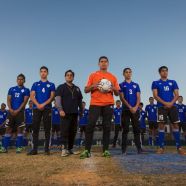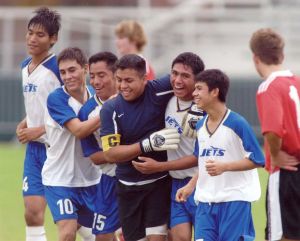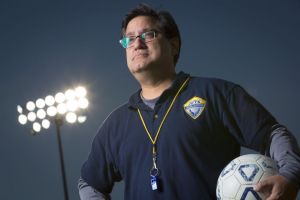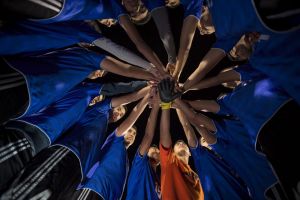Jets in the Sky
Just a few blocks east of the courtyard circle in downtown Pittsboro, North Carolina, smack dab in the middle of the state, sits the Small Café, a tiny establishment known for its lemon ricotta hotcakes, duck eggs, smashed potatoes, and the best coffee in town. Originally opened to provide a breakfast nook for the guests of the Small B&B, a collection of funky, artsy, tiny-house rooms for guests, the Café has outdone its original purpose. Dave and Lisa, the owners, now spend less time changing linens and more time slinging hash. That’s just fine with them, as the couple has learned that sometimes you just go with what works. Much like the café itself, Pittsboro is trying to learn some of that wisdom as it slowly leaves behind its country roots for something bigger. Pittsboro, like so much of Chatham County, is on the verge. Blessed or cursed, depending on who you ask, with being located so close to the Research Triangle Park, the little town, like the county, is evolving from the poultry processing and farming businesses of the past to a suburban bedroom community of the future. There are plans to turn Pittsboro from a town of 4,000 folks who greet each other by name at the grocery store to a 50,000-person monstrosity. As you can imagine, this is rather unsettling for a lot of people who moved here for the quiet of the country and a slower pace of life. But Pittsboro and Chatham County are both communities in transition, growing, changing, becoming less of one thing and more of another, trying to figure out what’s going to work. I am sitting at my corner table facing the double doors in the wood interior of the Small Café, having some coffee, waiting for the next embodiment of change that is sweeping the county and the country. And here he comes, a man on the verge.
Octavio Hernandez walks in with his usual swagger. He is dressed in blue jeans, a dark green T-shirt, and dusty tan work boots. Outside in the parking lot sits his new black Ford 250, crowding the lines in the parking lot. He has a broad grin on his brown face and a sunny look in his eyes when he spots me. A flood of memories hits me when I see him. It’s been ten years since he played for Los Jets, the Jordan-Matthews High School soccer team I coach in Siler City. Ten years ago, he helped us win support to create the program in the face of opposition against the growing Latino community, and ten years ago he helped to lead us to a state championship, the first predominantly Latino immigrant team in the South to win one. We haven’t seen each other in a long time. Octavio works out of state most of the time as an industrial welder erecting suspension bridges and office buildings of steel, cable, and glass. A few years before, he called me in the middle of the day.
“Cuadros.”
“Yes?” I didn’t quite recognize the voice behind the call.
“Cuadros, it’s Tavo. Do you know where I am?” he asked laughing. I could hear the wind roar in the background.
“No idea, Old Sport. Where?”
“I’m thirty stories up in the air, man,” he chuckled. “That’s like 240 feet, hombre!” He wanted to let me know where his life had taken him and it seemed to the top. I imagined the famous “Lunch atop a Skyscraper,” the 1932 black-and-white photograph of steelworkers sitting on a beam above New York City. Tavo was nowhere that high up but, having a childhood fear of heights, I felt instantly nervous for him. He said at first it bothered him but he got over it. He was happy he was building something. The workers at 30 Rock pictured on that beam having lunch have since given way to a new group of workers who call themselves los Vaqueros en el Cielo, or the Cowboys in the Sky. Most of them are Mexican. Tavo, who was born in Veracruz, Mexico, but grew up here, had joined a new team. He was still reaching for the sky.
Tavo sat down and right away I could tell that something was on his mind. The usual confidence he exuded was tamped down a bit. When Tavo walked into a room people felt his presence. I had seen that happen on a number of occasions. There was an electric air about him. He was an intense person. In all the photographs that I have seen of him when he played for Los Jets, he always had that “tale of the tape” stare-down look in his eyes that said, “I’m coming for you.” He was easy to spot in any picture because of it. I called it his heat vision and he used it to intimidate opponents. Today, that look was dimmed.
Tavo started in immediately saying he had been in town a month and had not been on the job since January. I asked what was up. Was he going back to school? No, he told me. After years working as a Cowboy in the Sky, he was looking to keep his feet closer to the ground. He had just started his own industrial welding erector business. He had spent months getting the licensing and workman’s compensation paperwork together so he could hire a crew and had spent countless of hours going over numbers to come up with the right bid to win a contract. But so far, he hadn’t won one and money was getting tight at home.
“I’ve got this guy, Cuadros,” he starts as he tells me his plan for the next month. “He said he’d get me a contract but I haven’t heard from him yet. I called him, twice. No answer.”
“You need to call him again, Tavo. You need to start bugging him until he answers. I know you may not want to do that, but you need an answer about the contract.” I have found that most people are afraid to call people back and get an answer one way or the other. They want to be polite but this is business.
Tavo explained that he had invested a good amount of money, not a whole lot that he couldn’t walk away from it and go back to the sky and work, but he wanted the business to succeed. He wanted to be the guy calling the shots on the ground. The guy making the big money. And that was him. Tavo was always looking for more. He had supreme confidence in himself and in an intangible faith that the currents of life would lead him to success. Maybe it was because Tavo was not afraid to dream and dream big. He was only eleven years old when he crossed the Sonoran Desert by himself, with a group of migrants and a smuggler. A mix-up had occurred at the border and an uncle who was going to go with him didn’t make it. He decided to go anyway. He spent five days under the burning sun and freezing nights drinking water from the dregs of cattle troughs to stay alive. He lost his fear in the desert and emerged with the knowledge that desire could overcome all obstacles, even the fear of death. Maybe Tavo walked out of the desert with a new determined strength because he had crossed that frontier for the purest reason a boy could have to risk his life. After five years, he wanted to see his father again.
It was that confidence that had stuck to him like sand in your shoes, that confidence won us a state championship and changed a community. Now he was sitting in front of me, his old soccer coach, seeking more guidance. Looking at him, tall, black hair, strong-limbed, I could tell his swagger was in check a bit. He would never admit it, but he was worried. He was part of the generation of Los Jets who came here at the turn of the twenty-first century in the Great Latino Migration, found a home, and are now settling down and planting roots. They’re getting married, having kids, adjusting their immigration status, and taking that second step in their journey. No longer immigrants, they’re now settlers, pioneers, building a new community in the American South as tall as the tallest skyscraper that Tavo has stood on.
Los Jets
I moved to Chatham County in 1999 on a journalism fellowship to write about emerging Latino communities in poultry towns in the South. Chatham was the perfect place for this at the time. With three processing plants, 300 chicken farmers, a hatchery and feed mill, the county was achicken county. And the chicken industry had been successful in recruiting workers south of the border to come and work in the plants for $6 an hour. It was so successful in attracting workers that the town of Siler City, a small, quiet community that so resembled Mayberry RFD that Frances Bavier, the actress who played Aunt Bea on the Andy Griffith Show, retired there with her cats to live out the rest of her days in seclusion, had begun to change into what some of the locals called “Mexico RFD.” It was that change in demographics that I was interested in writing about because I could see how this community and many other others in the South would also go through the same changes. And I wondered how these long-established communities, the ones that had struggled with race, segregation, and integration, would now cope with an entirely new set of people? Not too well, I found.
Siler City at that time was a community that didn’t know how to deal with its growing newcomer population. At times there was outreach and understanding, and at other times lines were drawn to prevent further incursion and change. One of those lines ran down the middle of the football field at Jordan-Matthews High School, the pride of the community. Siler City was a football town, not a fútbol town. Some people wanted to keep it that way.
There had been plenty of sad feelings from the longtime members of the community, the white population that was seeing their town change overnight. I remember hearing sighs and seeing eyes roll at how their community was becoming something else. But in 2000, another emotion bubbled out and this time it was anger. Things came to a head when some locals decided they needed to voice their opposition to the “changes” in town. At first, it was to be a small rally in front of City Hall by locals. Later, when David Duke, the former Grand Dragon of the Ku Klux Klan in Louisiana, was invited to speak it was clear this was a Klan rally in disguise. This was one of the first anti-immigrant rallies against Latinos in the South but it wasn’t the last, and right-wing hate groups picked up on this tension and began to stoke nativism and increase their membership. When the rally finally took place, it was smaller than expected. Many longtime Siler City residents who may have resented the influx of Latinos knew better than to go City Hall and support Duke’s group. And many folks had to take a hard look at their feelings about the newcomers and how they were to be welcomed.
As for David Duke, he spent more than an hour bashing the poultry workers and Mexicans and calling for their deportation and removal—much of the same rhetoric you hear today on the campaign trail from some of our presidential candidates. After the rally Duke went to a nearby Golden Corral for lunch where he helped himself to a big plate of fried chicken.
During this time I had been coaching a soccer team of Latino middle school boys in the local soccer league and we were having tremendous success. The boys had never played organized soccer before, just street ball or pick-up games, what they called la cascarita. But they had skill. When they told me about being turned down to create a varsity program at the high school, I did something most writers don’t. I got involved. After two years, we prevailed with the help of some local politicians and got the team created. We were instant winners. By the third season we were state champions and Tavo was the MVP for having scored the game-winning goal. When our bus drove back through the streets of Siler City, people came out and cheered the team. We were all Jets that day.
Since that season in 2004, I have continued to coach Los Jets and the Jets of yesterday are not the Jets of today. The teams today are the little brothers of those champions—the boys who came speaking no English, with no papers, not understanding the customs, and having to cope with a community that didn’t want them and were afraid of them. In my book about Los Jets and Siler City, A Home on the Field, it seems like a fairy tale ending, a struggle to overcome the prejudices to form the team and then a state championship in three years, a Disneyesque ending. But the epilogue tells a more realistic and harsher story of immigration today. In the epilogue, only one player goes on to higher education and completes a degree. The rest go into the trades and try to fashion a life where their lack of documentation stymies their dreams. The ending shows the sad truth that not having a pathway to citizenship is a roadblock in life. It says that the promise of America is broken. That once upon a time we welcomed immigrants with few qualifications other than the desire to do better, and although we exploited the parents, we allowed the kids to become citizens. Today that is no longer true.
Today’s Jets are very different; born here, more integrated, fluent in English and Spanish, all wanting to go on to college. Few now have even seen the desert. And Siler City is not the town it once was. Today it is more than half Latino.
At His Best
When the message came through on Facebook, I was taken aback. Adrian Moreno, a former player, skilled but headstrong, was asking for my address. He had played with Los Jets for two seasons and then quit to pursue other things. His life had gone off track in high school. But he had gotten himself together and graduated and gone on to community college and was now finishing up a degree at a four-year college. He had turned his life around. He was messaging me to ask me to come to his wedding. He had not had a lot of adult supervision growing up and he wanted me to come to see how he turned out. He wanted someone from that time when he was a kid to see the man he had grown up to be.
The Lighthouse Freewill Baptist Church sits way out in the country south of Siler City, a small church with a large Latino congregation. Next to the church is a large trailer used for dinners and gatherings. When I pulled up to the church, cars were lined up and down the road. Tables and chairs were set up outside under a tent. The air was brisk and chilly but the Carolina sun shone down like a heat lamp, making it pleasant. I looked around for Adrian and his bride but didn’t see them. I went inside the trailer for the reception. It was like stepping into a nursery. All over the trailer and the grounds, little children dressed in their Sunday best scampered around asking for food, crying, playing, and generally making a ruckus. This was a normal scene in Siler City on a Saturday. You can’t spit without hitting a christening, a baby shower, a wedding shower, a wedding reception, or an engagement party. This is a young community. The second generation from the Great Migration was already here in tiny stiff waistcoats asking for more cake. It was the future of Siler City and the South. This is true in every elementary public school classroom in the region.
I spotted Adrian and his bride Jenyfer and they welcomed me. We posed for a quick picture. Everyone wanted a piece of their time and it was chaos. Jenyfer was beautiful and sweet and welcomed me warmly. I told her not to worry too much about the commotion, it’s a wedding and you just have to go with it. Adrian was genuinely touched to see me. Dressed in a tuxedo, he wrapped his arm around me, his old coach who saw him at his worst and could now see him at his best.
When I left, I left behind all the little kids playing soccer in the church playground. I thought I probably wouldn’t be around to coach them but I would feel their presence.
A Night at the Museum
It has taken us three years to get approval for the “Los Jets, Playing for the American Dream,” exhibit at the North Carolina Museum of History in downtown Raleigh. But here it is. The exhibit itself is a glass box about twelve feet by nine feet and contains mannequins wearing the original uniforms of the championship team, the state championship trophy, plaques and awards given to individual players including Tavo’s MVP award, rings, and even the original iron chain that I used to inspire the team to grab onto before the start of our matches. There are photographs, clips from the documentary television series “Los Jets,” produced by Jennifer Lopez, and labels telling the story of the team and the struggle to get it established. These artifacts are now a part of North Carolina history.
It is opening night and some 200 people have come to watch me and players from the championship team, along with some of the newer players, cut the ribbon. Some 200,000 spectators will see and get to touch and know the story of a group of immigrant boys with big dreams and a deep desire to become a part of their new community. The labels talk about immigrants but they also speak about settlers and pioneers. And that’s where this community is today. They are settling, becoming a part of the American South, pioneers making their own history to mingle with the greater Southern story.
Tavo could not be there that night. He was in Washington, D.C., with his wife and son, both U.S. citizens. I missed him but I knew that he would see the exhibit and see his dream made into reality. The television monitor in the exhibit played his spectacular game-winning shot, his golazo, from thirty-five yards that beat the keeper on the far post. His son Aiden would get a big kick out of it.
Tavo called me later to tell me he had gotten his first contract to build steel staircases in a four-story apartment complex. He had won the bid. He was on the verge again.










